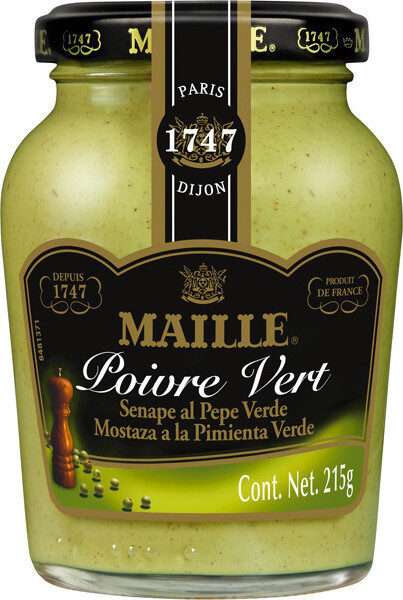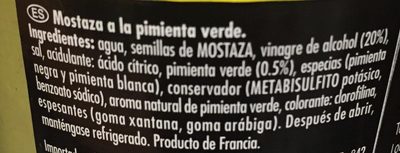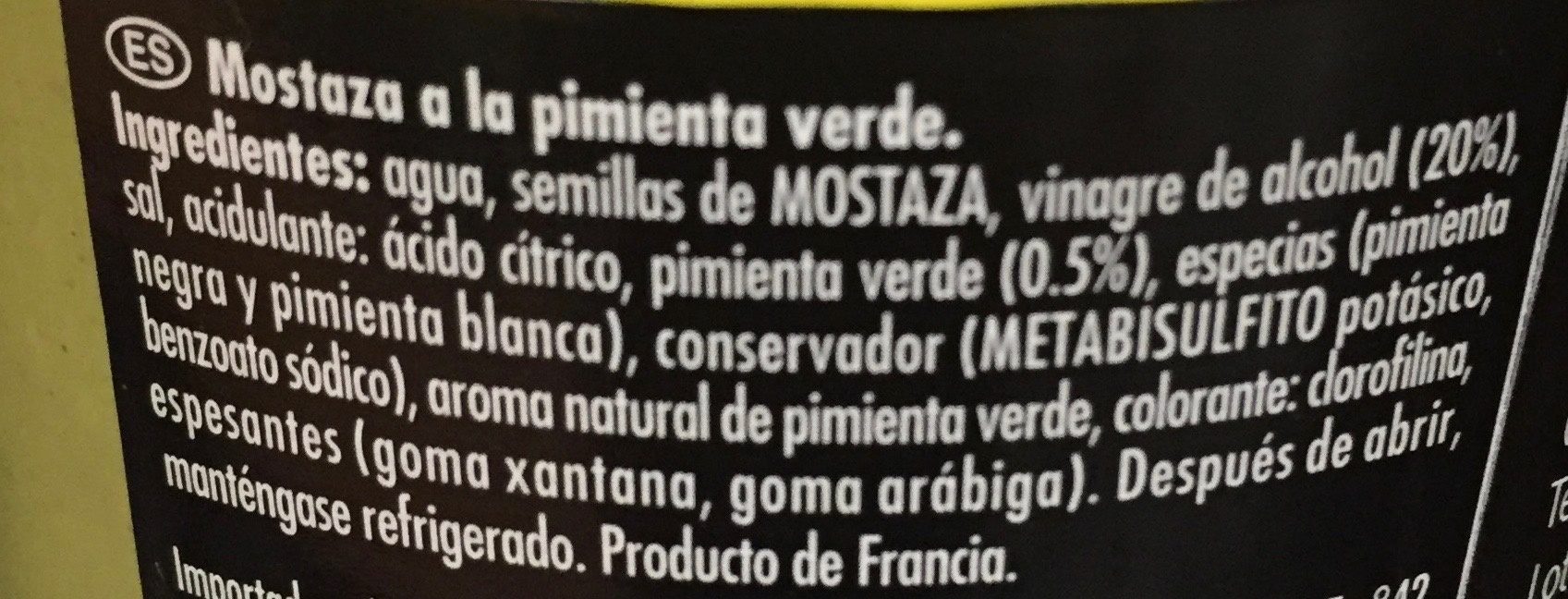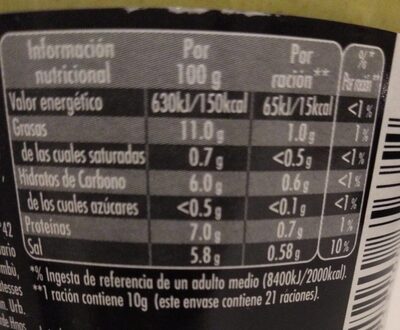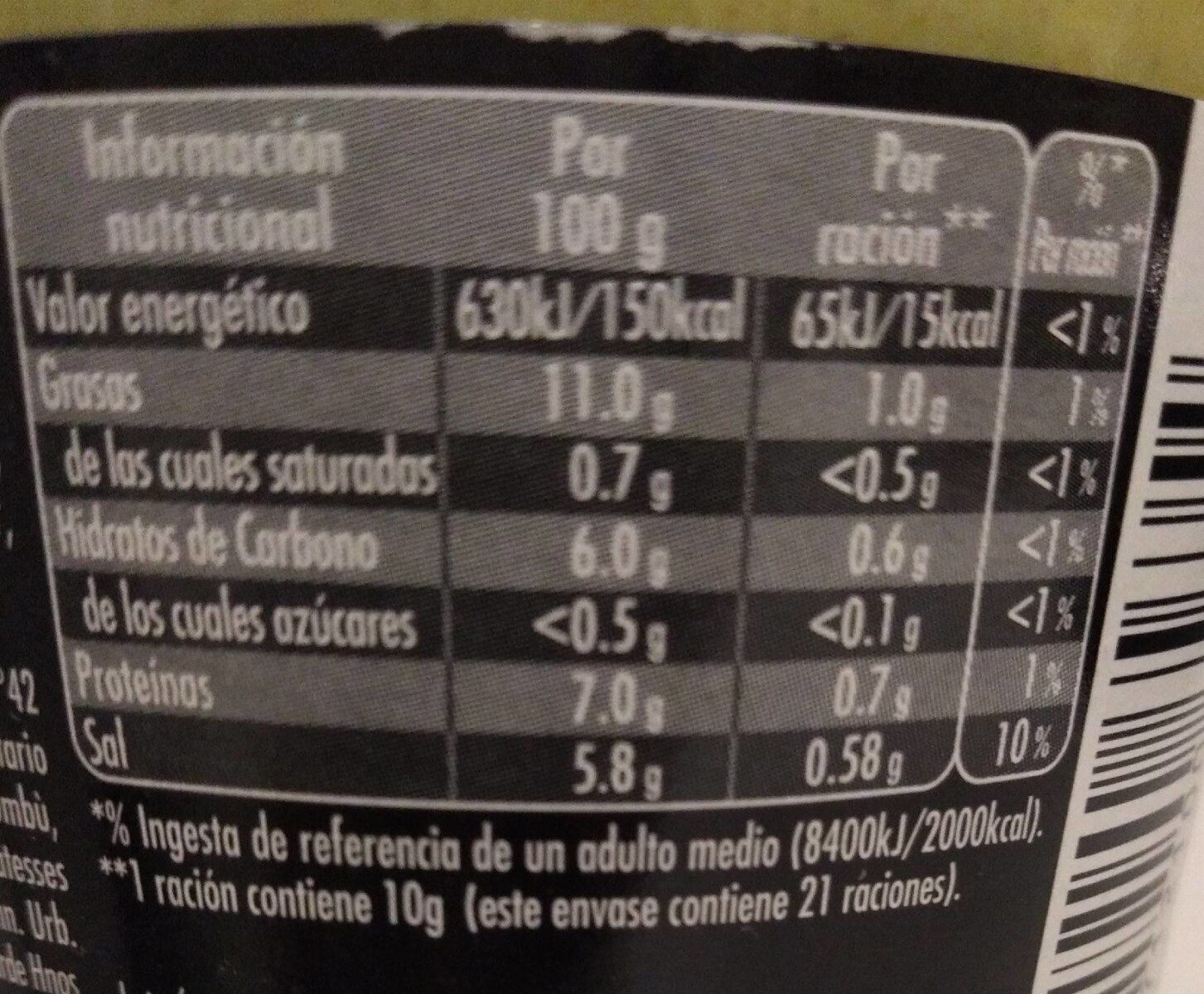Help us make food transparency the norm!
As a non-profit organization, we depend on your donations to continue informing consumers around the world about what they eat.
The food revolution starts with you!
Mostaza a la pimienta verde tarro - Maille - 215 g,
Mostaza a la pimienta verde tarro - Maille - 215 g,
This product page is not complete. You can help to complete it by editing it and adding more data from the photos we have, or by taking more photos using the app for Android or iPhone/iPad. Thank you!
×
Barcode: 8712100656354 (EAN / EAN-13)
Common name: Mostaza a la pimienta verde Poivre Vert
Quantity: 215 g,
Packaging: Glass, Pouch flask
Brands: Maille
Categories: Condiments, Sauces, Mustards, es:Mostazas con pimienta verde
Origin of ingredients: France
Manufacturing or processing places: Francia
Countries where sold: Mexico
Matching with your preferences
Health
Ingredients
-
18 ingredients
: Agua, semillas de Mostaza, vinagre de alcohol (20%), sal acidulante: ácido cítrico, pimienta verde (0,5%), especias (pimienta negra y pimienta blanca), conservador (Metabisulfito potásico, benzoato sódico) aroma natural de pimienta verde, colorante: clorofilina, espesantes (goma xantana, goma arábiga).Allergens: Mustard
Food processing
-
Ultra processed foods
Elements that indicate the product is in the 4 - Ultra processed food and drink products group:
- Additive: E140 - Chlorophylls and Chlorophyllins
- Additive: E414 - Acacia gum
- Additive: E415 - Xanthan gum
- Ingredient: Colour
- Ingredient: Thickener
Food products are classified into 4 groups according to their degree of processing:
- Unprocessed or minimally processed foods
- Processed culinary ingredients
- Processed foods
- Ultra processed foods
The determination of the group is based on the category of the product and on the ingredients it contains.
Additives
-
E140 - Chlorophylls and Chlorophyllins
Chlorophyll d: Chlorophyll d is a form of chlorophyll, identified by Harold Strain and Winston Manning in 1943. It is present in cyanobacteria which use energy captured from sunlight for photosynthesis. Chlorophyll d absorbs far-red light, at 710 nm wavelength, just outside the optical range. An organism that contains chlorophyll d is adapted to an environment such as moderately deep water, where it can use far red light for photosynthesis, although there is not a lot of visible light.Source: Wikipedia
-
E140ii - Chlorophyllins
Chlorophyll d: Chlorophyll d is a form of chlorophyll, identified by Harold Strain and Winston Manning in 1943. It is present in cyanobacteria which use energy captured from sunlight for photosynthesis. Chlorophyll d absorbs far-red light, at 710 nm wavelength, just outside the optical range. An organism that contains chlorophyll d is adapted to an environment such as moderately deep water, where it can use far red light for photosynthesis, although there is not a lot of visible light.Source: Wikipedia
-
E211 - Sodium benzoate
Sodium benzoate: Sodium benzoate is a substance which has the chemical formula NaC7H5O2. It is a widely used food preservative, with an E number of E211. It is the sodium salt of benzoic acid and exists in this form when dissolved in water. It can be produced by reacting sodium hydroxide with benzoic acid.Source: Wikipedia
-
E224 - Potassium metabisulphite
Potassium metabisulfite: Potassium metabisulfite, K2S2O5, also known as potassium pyrosulfite, is a white crystalline powder with a pungent sulfur odour. The main use for the chemical is as an antioxidant or chemical sterilant. It is a disulfite and is chemically very similar to sodium metabisulfite, with which it is sometimes used interchangeably. Potassium metabisulfite is generally preferred out of the two as it does not contribute sodium to the diet. Potassium metabisulfite has a monoclinic crystal structure which decomposes at 190 °C, yielding potassium sulfite and sulfur dioxide: K2S2O5-s- → K2SO3-s- + SO2-g-Source: Wikipedia
-
E330 - Citric acid
Citric acid is a natural organic acid found in citrus fruits such as lemons, oranges, and limes.
It is widely used in the food industry as a flavor enhancer, acidulant, and preservative due to its tart and refreshing taste.
Citric acid is safe for consumption when used in moderation and is considered a generally recognized as safe (GRAS) food additive by regulatory agencies worldwide.
-
E414 - Acacia gum
Gum arabic: Gum arabic, also known as acacia gum, arabic gum, gum acacia, acacia, Senegal gum and Indian gum, and by other names, is a natural gum consisting of the hardened sap of various species of the acacia tree. Originally, gum arabic was collected from Acacia nilotica which was called the "gum arabic tree"; in the present day, gum arabic is collected from acacia species, predominantly Acacia senegal and Vachellia -Acacia- seyal; the term "gum arabic" does not indicate a particular botanical source. In a few cases so‐called "gum arabic" may not even have been collected from Acacia species, but may originate from Combretum, Albizia or some other genus. Producers harvest the gum commercially from wild trees, mostly in Sudan -80%- and throughout the Sahel, from Senegal to Somalia—though it is historically cultivated in Arabia and West Asia. Gum arabic is a complex mixture of glycoproteins and polysaccharides. It is the original source of the sugars arabinose and ribose, both of which were first discovered and isolated from it, and are named after it. Gum arabic is soluble in water. It is edible, and used primarily in the food industry as a stabilizer, with EU E number E414. Gum arabic is a key ingredient in traditional lithography and is used in printing, paint production, glue, cosmetics and various industrial applications, including viscosity control in inks and in textile industries, though less expensive materials compete with it for many of these roles. While gum arabic is now produced throughout the African Sahel, it is still harvested and used in the Middle East.Source: Wikipedia
-
E415 - Xanthan gum
Xanthan gum (E415) is a natural polysaccharide derived from fermented sugars, often used in the food industry as a thickening and stabilizing agent.
This versatile food additive enhances texture and prevents ingredient separation in a wide range of products, including salad dressings, sauces, and gluten-free baked goods.
It is considered safe for consumption even at high intake amounts.
Ingredients analysis
-
Palm oil free
No ingredients containing palm oil detected
Unrecognized ingredients: es:sal-acidulante, es:aroma-natural-de-pimienta-verdeSome ingredients could not be recognized.
We need your help!
You can help us recognize more ingredients and better analyze the list of ingredients for this product and others:
- Edit this product page to correct spelling mistakes in the ingredients list, and/or to remove ingredients in other languages and sentences that are not related to the ingredients.
- Add new entries, synonyms or translations to our multilingual lists of ingredients, ingredient processing methods, and labels.
If you would like to help, join the #ingredients channel on our Slack discussion space and/or learn about ingredients analysis on our wiki. Thank you!
-
Vegan status unknown
Unrecognized ingredients: es:sal-acidulante, es:aroma-natural-de-pimienta-verdeSome ingredients could not be recognized.
We need your help!
You can help us recognize more ingredients and better analyze the list of ingredients for this product and others:
- Edit this product page to correct spelling mistakes in the ingredients list, and/or to remove ingredients in other languages and sentences that are not related to the ingredients.
- Add new entries, synonyms or translations to our multilingual lists of ingredients, ingredient processing methods, and labels.
If you would like to help, join the #ingredients channel on our Slack discussion space and/or learn about ingredients analysis on our wiki. Thank you!
-
Vegetarian status unknown
Unrecognized ingredients: es:sal-acidulante, es:aroma-natural-de-pimienta-verdeSome ingredients could not be recognized.
We need your help!
You can help us recognize more ingredients and better analyze the list of ingredients for this product and others:
- Edit this product page to correct spelling mistakes in the ingredients list, and/or to remove ingredients in other languages and sentences that are not related to the ingredients.
- Add new entries, synonyms or translations to our multilingual lists of ingredients, ingredient processing methods, and labels.
If you would like to help, join the #ingredients channel on our Slack discussion space and/or learn about ingredients analysis on our wiki. Thank you!
-
Details of the analysis of the ingredients
We need your help!
Some ingredients could not be recognized.
We need your help!
You can help us recognize more ingredients and better analyze the list of ingredients for this product and others:
- Edit this product page to correct spelling mistakes in the ingredients list, and/or to remove ingredients in other languages and sentences that are not related to the ingredients.
- Add new entries, synonyms or translations to our multilingual lists of ingredients, ingredient processing methods, and labels.
If you would like to help, join the #ingredients channel on our Slack discussion space and/or learn about ingredients analysis on our wiki. Thank you!
: Agua, semillas de Mostaza, vinagre de alcohol 20%, sal acidulante (ácido cítrico), pimienta verde 0.5%, especias (pimienta negra, pimienta blanca), conservador (Metabisulfito potásico, benzoato sódico), aroma natural de pimienta verde, colorante (clorofilina), espesantes (goma xantana, goma arábiga)- Agua -> en:water - vegan: yes - vegetarian: yes - ciqual_food_code: 18066 - percent_min: 20 - percent_max: 59
- semillas de Mostaza -> en:mustard-seed - vegan: yes - vegetarian: yes - ciqual_food_code: 11013 - percent_min: 20 - percent_max: 39.5
- vinagre de alcohol -> en:alcohol-vinegar - vegan: yes - vegetarian: yes - ciqual_food_code: 11018 - percent_min: 20 - percent: 20 - percent_max: 20
- sal acidulante -> es:sal-acidulante - percent_min: 0.5 - percent_max: 20
- ácido cítrico -> en:e330 - vegan: yes - vegetarian: yes - percent_min: 0.5 - percent_max: 20
- pimienta verde -> en:green-pepper - vegan: yes - vegetarian: yes - percent_min: 0.5 - percent: 0.5 - percent_max: 0.5
- especias -> en:spice - vegan: yes - vegetarian: yes - percent_min: 0 - percent_max: 0.5
- pimienta negra -> en:black-pepper - vegan: yes - vegetarian: yes - ciqual_food_code: 11015 - percent_min: 0 - percent_max: 0.5
- pimienta blanca -> en:white-pepper - vegan: yes - vegetarian: yes - ciqual_food_code: 11019 - percent_min: 0 - percent_max: 0.25
- conservador -> en:preservative - percent_min: 0 - percent_max: 0.5
- Metabisulfito potásico -> en:e224 - vegan: yes - vegetarian: yes - percent_min: 0 - percent_max: 0.5
- benzoato sódico -> en:e211 - vegan: yes - vegetarian: yes - percent_min: 0 - percent_max: 0.25
- aroma natural de pimienta verde -> es:aroma-natural-de-pimienta-verde - percent_min: 0 - percent_max: 0.5
- colorante -> en:colour - percent_min: 0 - percent_max: 0.5
- clorofilina -> en:e140ii - vegan: yes - vegetarian: yes - percent_min: 0 - percent_max: 0.5
- espesantes -> en:thickener - percent_min: 0 - percent_max: 0.5
- goma xantana -> en:e415 - vegan: yes - vegetarian: yes - percent_min: 0 - percent_max: 0.5
- goma arábiga -> en:e414 - vegan: yes - vegetarian: yes - percent_min: 0 - percent_max: 0.25
Nutrition
-
Poor nutritional quality
⚠ ️Warning: the amount of fruits, vegetables and nuts is not specified on the label, it was estimated from the list of ingredients: 0This product is not considered a beverage for the calculation of the Nutri-Score.
Positive points: 0
- Proteins: 4 / 5 (value: 7, rounded value: 7)
- Fiber: 0 / 5 (value: 0.2, rounded value: 0.2)
- Fruits, vegetables, nuts, and colza/walnut/olive oils: 0 / 5 (value: 0, rounded value: 0)
Negative points: 11
- Energy: 1 / 10 (value: 628, rounded value: 628)
- Sugars: 0 / 10 (value: 0.5, rounded value: 0.5)
- Saturated fat: 0 / 10 (value: 0.7, rounded value: 0.7)
- Sodium: 10 / 10 (value: 2320, rounded value: 2320)
The points for proteins are not counted because the negative points are greater or equal to 11.
Nutritional score: (11 - 0)
Nutri-Score:
-
Nutrient levels
-
Fat in moderate quantity (11%)
What you need to know- A high consumption of fat, especially saturated fats, can raise cholesterol, which increases the risk of heart diseases.
Recommendation: Limit the consumption of fat and saturated fat- Choose products with lower fat and saturated fat content.
-
Saturated fat in low quantity (0.7%)
What you need to know- A high consumption of fat, especially saturated fats, can raise cholesterol, which increases the risk of heart diseases.
Recommendation: Limit the consumption of fat and saturated fat- Choose products with lower fat and saturated fat content.
-
Sugars in low quantity (0.5%)
What you need to know- A high consumption of sugar can cause weight gain and tooth decay. It also augments the risk of type 2 diabetes and cardio-vascular diseases.
Recommendation: Limit the consumption of sugar and sugary drinks- Sugary drinks (such as sodas, fruit beverages, and fruit juices and nectars) should be limited as much as possible (no more than 1 glass a day).
- Choose products with lower sugar content and reduce the consumption of products with added sugars.
-
Salt in high quantity (5.8%)
What you need to know- A high consumption of salt (or sodium) can cause raised blood pressure, which can increase the risk of heart disease and stroke.
- Many people who have high blood pressure do not know it, as there are often no symptoms.
- Most people consume too much salt (on average 9 to 12 grams per day), around twice the recommended maximum level of intake.
Recommendation: Limit the consumption of salt and salted food- Reduce the quantity of salt used when cooking, and don't salt again at the table.
- Limit the consumption of salty snacks and choose products with lower salt content.
-
-
Nutrition facts
Nutrition facts As sold
for 100 g / 100 mlAs sold
per serving (100 g,)Compared to: Mustards Energy 628 kj
(150 kcal)628 kj
(150 kcal)+2% Fat 11 g 11 g +32% Saturated fat 0.7 g 0.7 g +5% Carbohydrates 6 g 6 g -21% Sugars 0.5 g 0.5 g -89% Fiber 0.2 g 0.2 g -90% Proteins 7 g 7 g +34% Salt 5.8 g 5.8 g +43% Fruits‚ vegetables‚ nuts and rapeseed‚ walnut and olive oils (estimate from ingredients list analysis) 0 % 0 %
Environment
-
Eco-Score B - Low environmental impact
⚠ ️Select a country in order to include the full impact of transportation.The Eco-Score is an experimental score that summarizes the environmental impacts of food products.→ The Eco-Score was initially developped for France and it is being extended to other European countries. The Eco-Score formula is subject to change as it is regularly improved to make it more precise and better suited to each country.Life cycle analysis
-
Average impact of products of the same category: B (Score: 74/100)
Category: Mustard
Category: Mustard
- PEF environmental score: 0.31 (the lower the score, the lower the impact)
- including impact on climate change: 1.83 kg CO2 eq/kg of product
Stage Impact Agriculture
58.1 %Processing
13.5 %Packaging
21.1 %Transportation
5.7 %Distribution
1.5 %Consumption
0.0 %
Bonuses and maluses
-
Origins of ingredients with a medium impact
Bonus: +4
Environmental policy: +4
Transportation: 0
Origin of the product and/or its ingredients % of ingredients Impact France 100 %Medium
-
Packaging with a low impact
Malus: -2
Shape Material Recycling Impact Pouch flask Glass Low
Eco-Score for this product
-
Impact for this product: B (Score: 76/100)
Product: Mostaza a la pimienta verde tarro - Maille - 215 g
Life cycle analysis score: 74
Sum of bonuses and maluses: +2
Final score: 76/100
-
Carbon footprint
-
Equal to driving 0.9 km in a petrol car
183 g CO² per 100g of product
The carbon emission figure comes from ADEME's Agribalyse database, for the category: Mustard (Source: ADEME Agribalyse Database)
Stage Impact Agriculture
39.9 %Processing
12.9 %Packaging
34.2 %Transportation
11.9 %Distribution
1.1 %Consumption
0.0 %
Packaging
-
Packaging with a low impact
-
Packaging parts
Pouch flask (Glass)
-
Packaging materials
Material % Packaging weight Packaging weight per 100 g of product Glass
-
Transportation
-
Origins of ingredients
Origins of ingredients with a medium impact
Origin of the product and/or its ingredients % of ingredients Impact France 100 %Medium
Report a problem
-
Incomplete or incorrect information?
Category, labels, ingredients, allergens, nutritional information, photos etc.
If the information does not match the information on the packaging, please complete or correct it. Open Food Facts is a collaborative database, and every contribution is useful for all.
Data sources
Product added on by openfoodfactsmx7
Last edit of product page on by teolemon.
Product page also edited by kiliweb, packbot, yuka.UnBBTE1ZMEsrY01Ha3NNZTBSWFQvT05zeWJLa1FXU3JkTm93SVE9PQ, yuka.sY2b0xO6T85zoF3NwEKvlnxHCYXXgxvePRHimka33N2Ud82yTdxUuavwHao.

